The economy of Saudi Arabia will continue to fiscally impress in 2017 in lockstep with the kingdom's reform programme. Improved oil prices will have a positive effect on confidence more than on headline GDP. What will sway the headline growth figures will be the production cuts that Saudi Arabia will undertake in the first six months of Opec's output reductions. For 2017, real GDP will grow by 0.8 per cent from 1.4 per cent last year. There will be a slight improvement in growth in the crucial non-oil sector to 1 per cent in 2017 from 0.1 per cent in 2016.
The slowdown in 2016 was mainly because of negative sentiment associated with lower oil prices and reduced government spending. These affected business and consumer confidence, and reduced banks’ lending appetite. Construction activity in 2016 contracted significantly as the government consolidated its capital investment projects.
Growth in the non-oil private sector is expected to accelerate slightly as the expansionary budget in 2017 stimulates non-oil economic activity. However, there are downside risks to growth in the form of lower consumer spending because of the recent cuts to public-sector workers’ allowances, and the potential for higher costs for doing business such as energy price increases, and newly introduced fees on municipal, immigration and other government services. The implementation of the National Transformation Program (NTP) in 2017 will stimulate some private activity, particularly initiatives such as the foreign direct investment promotion programme, the Saudi household cash-transfer programme, local content development and regulatory and administrative reform. In 2017, from a sectoral point of view, expect non-oil mining, finance and utilities to be the fastest growing sectors of the economy.
Rebalancing public finances will be important to reach the government’s targeted goal of a surplus by 2020. Reducing expenditures is important in a lower oil price environment. The government announced in October that projects worth 1 trillion riyals (Dh979.5 billion) will be cancelled. The announcement follows a series of far-reaching cuts elsewhere, including a 50 per cent increase in petrol prices, a freeze on ordinary civil servants’ basic salaries and the termination of their annual bonuses. These built on sharp cuts to the capital budget, with transport and building projects scaled back or cancelled.
With fiscal adjustment needing to proceed, but likely to have a negative short-term effect on growth and employment, it would be important to introduce growth-enhancing structural reforms to help offset this effect. The effect of slower growth on the banking sector is sure to be felt, but according to the latest report issued by Moody’s, Saudi banks’ profitability is expected to continue to outperform other GCC banking systems.
In 2016, Saudi banks reported a 5.4 per cent year-on-year decrease in net profits, mainly because of rising provisioning charges, a credit negative. The provisioning increase reflects asset quality challenges amid low oil prices. Besides boosting confidence, the 105bn riyals that the Saudi government paid to contractors in the fourth quarter last year led to large repayments to banks. The repayment to contractors, combined with a US$17.5bn international sovereign bond issuance in October that injected liquidity into the banking system and various accommodative monetary policy measures, contributed to a 1.1 per cent increase in bank deposits in the fourth quarter – versus a 1.1 per cent decline in the second quarter and 0.2 per cent decline in the third quarter – and a 0.9 per cent year-on-year increase in bank deposits last year.
Having risen sharply to more than 4 per cent in the first half of last year, reflecting increases in petrol prices and electricity and water bills, year-on-year inflation eased in the third quarter, to 3.4 per cent, on the back of weak domestic demand and falling food prices. Inflation is expected to slow further in 2017, reaching 2.3 per cent, mainly owing to a higher base, particularly during the first half of the year. The new round of energy price hikes by mid-2017 will push inflation up, but falling demand-price pressures will keep the average headline number subdued. However, with the government introducing value-added tax in January 2018 at about 5 per cent, average consumer price growth will move back above 3.6 per cent in that year.
The government has to continue to push with two important programmes that bring medium-term strength to the economy. The continuing reforms to strengthen the business environment and encourage SME development are essential for growth. The recent decision to open fully the retail and wholesale sectors to foreign investment and the introduction of the new companies law – which reduces the administrative burden on SMEs, strengthens minority shareholder rights and improves corporate governance – are steps in the right direction. Work is also continuing on the new insolvency law and stronger contract enforcement – difficulties resolving insolvencies and uncertainties about contract enforcement are cited as impediments to doing business.
Despite this still-difficult environment, the imbalances the kingdom faces will be funded. In particular, the trade and current account shortfall will be comfortably financed and Saudi Arabia’s long-standing currency peg will remain in place. The external account will be further buttressed by rising export volumes of aluminium, phosphate and petrochemicals – the latter boosted by the ramping up of production at the giant Sadara integrated chemical plant – which should ensure that the trade balance is less challenged. The improving trade performance will be augmented by a stronger non-merchandise account as the government’s workforce nationalisation programme is deepened.
Privatisation and public-private partnerships (PPP) have been part of Saudi Arabia’s efforts to increase the role of the private sector in the economy since the early 2000s. Nonetheless, the size of the government remains large in terms of its stake in public enterprises and its spending and investment. A deepening of the privatisation and PPP programmes could be an important part of reducing the government’s involvement in the economy and boosting productivity. Overall, 2017 will be a better year than 2016 as the economy is beginning to adjust.
John Sfakianakis is the director of economic research at the Gulf Research Centre in Riyadh.
Read the full National Transformation Program here.
business@thenational.ae
Follow The National's Business section on Twitter





